
Gymnastics
Encyclopedia
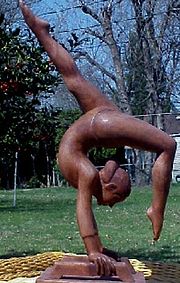
Sport
A Sport is all forms of physical activity which, through casual or organised participation, aim to use, maintain or improve physical fitness and provide entertainment to participants. Sport may be competitive, where a winner or winners can be identified by objective means, and may require a degree...
involving performance of exercises requiring physical strength, flexibility, agility, coordination, and balance. Internationally, all of the gymnastic sports are governed by the Fédération Internationale de Gymnastique
Fédération Internationale de Gymnastique
The Fédération Internationale de Gymnastique or International Federation of Gymnastics is the governing body of competitive gymnastics. Its headquarters is in Lausanne, Switzerland. It was founded on July 23, 1881 in Liège, Belgium, making it the oldest international sport organisation...
(FIG) with each country having its own national governing body affiliated to FIG. Competitive Artistic gymnastics
Artistic gymnastics
Artistic gymnastics is a discipline of gymnastics where gymnasts perform short routines on different apparatus, with less time for vaulting . The sport is governed by the Federation Internationale de Gymnastique , which designs the Code of Points and regulates all aspects of international elite...
is the best known of the gymnastic sports. It typically involves the women's events of uneven parallel bars, balance beam
Balance beam (gymnastics)
The balance beam is an artistic gymnastics apparatus, as well as the event performed using the apparatus. Both the apparatus and the event are sometimes referred to as simply "beam". The English abbreviation for the event in gymnastics scoring is BB....
, floor exercise
Floor (gymnastics)
In gymnastics, the floor refers to a specially prepared exercise surface, which is considered an apparatus. It is used by both male and female gymnasts. The event in gymnastics performed on floor is called floor exercise. The English abbreviation for the event in gymnastics scoring is FX.A spring...
, and vault
Vault (gymnastics)
The vault is an artistic gymnastics apparatus, as well as the skill performed using that apparatus. Vaulting is also the action of performing a vault. Both male and female gymnasts perform the vault...
. Men's events include floor exercise
Floor (gymnastics)
In gymnastics, the floor refers to a specially prepared exercise surface, which is considered an apparatus. It is used by both male and female gymnasts. The event in gymnastics performed on floor is called floor exercise. The English abbreviation for the event in gymnastics scoring is FX.A spring...
, pommel horse
Pommel horse
The pommel horse is an artistic gymnastics apparatus. Traditionally, it is used by only male gymnasts. Originally made of a metal frame with a wooden body and a leather cover, modern pommel horses have a metal body covered with foam rubber and leather, with plastic handles .- History :The pommel...
, still rings
Rings (gymnastics)
The rings, also known as still rings , is an artistic gymnastics apparatus and the event that uses it. It is traditionally used only by male gymnasts, due to its extreme upper-body strength requirements...
, vault
Vault (gymnastics)
The vault is an artistic gymnastics apparatus, as well as the skill performed using that apparatus. Vaulting is also the action of performing a vault. Both male and female gymnasts perform the vault...
, parallel bars, and high bar
Horizontal bar
The high bar, also known as the horizontal bar, is an apparatus used by male gymnasts in Artistic Gymnastics. It traditionally consists of a cylindrical metal bar that is rigidly held above and parallel to the floor by a system of cables and stiff vertical supports. Gymnasts typically wear leather...
. Gymnastics evolved from exercises used by the ancient Greeks, that included skills for mounting and dismounting a horse, and from circus performance skills.
Other gymnastic sports include rhythmic gymnastics
Rhythmic gymnastics
Rhythmic gymnastics is a sport in which individuals or teams of competitors manipulate one or two pieces of apparatus: rope, clubs, hoop, ball, ribbon and Free . An individual athlete only manipulates 1 apparatus at a time...
, the various trampolining
Trampolining
Trampolining is a competitive Olympic sport in which gymnasts perform acrobatics while bouncing on a trampoline. These can include simple jumps in the pike, tuck or straddle position to more complex combinations of forward or backward somersaults and twists....
sports, aerobic and acrobatic gymnastics.
Participants can include children as young as five years old doing kindergym and children's gymnastics, recreational gymnasts of ages 5 and up, competitive gymnasts at varying levels of skill, and world class athletes.
Etymology
The word derives from the GreekGreek language
Greek is an independent branch of the Indo-European family of languages. Native to the southern Balkans, it has the longest documented history of any Indo-European language, spanning 34 centuries of written records. Its writing system has been the Greek alphabet for the majority of its history;...
γυμναστική (gymnastike), fem. of γυμναστικός (gymnastikos), "fond of athletic exercises", from γυμνάσια (gymnasia), "exercise" and that from γυμνός (gymnos), "naked", because athletes exercised and competed without clothing.
History
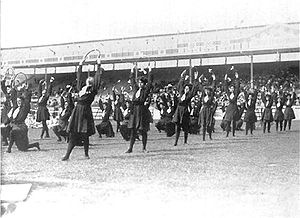
Ancient Greece
Ancient Greece is a civilization belonging to a period of Greek history that lasted from the Archaic period of the 8th to 6th centuries BC to the end of antiquity. Immediately following this period was the beginning of the Early Middle Ages and the Byzantine era. Included in Ancient Greece is the...
began with athletic feats performed by each individual according to his own notion. The youth were encouraged to combine amusement with exercise. In time, this kind of exercise was incorporated into a system that figured prominently in the state regulations for education. In fact, the period for exercise or gymnastics was equal to the time spent on art and music combined. All Greek cities had a gymnasium
Gymnasium (ancient Greece)
The gymnasium in ancient Greece functioned as a training facility for competitors in public games. It was also a place for socializing and engaging in intellectual pursuits. The name comes from the Ancient Greek term gymnós meaning "naked". Athletes competed in the nude, a practice said to...
, a courtyard for jumping, running, and wrestling.
As the Roman Empire
Roman Empire
The Roman Empire was the post-Republican period of the ancient Roman civilization, characterised by an autocratic form of government and large territorial holdings in Europe and around the Mediterranean....
ascended, the Greek gymnastics gave way to gymnastics whose purpose was military training. The Romans, for example, introduced the wooden horse.
In 393 AD the Emperor Theodosius abolished the Olympic Games, which by then had become corrupt and gymnastics, along with other sports, declined. For centuries, gymnastics was all but forgotten.
In the fifteenth century, Girolamo Mercuriale from Forlì
Forlì
Forlì is a comune and city in Emilia-Romagna, Italy, and is the capital of the province of Forlì-Cesena. The city is situated along the Via Emilia, to the right of the Montone river, and is an important agricultural centre...
(Italy
Italy
Italy , officially the Italian Republic languages]] under the European Charter for Regional or Minority Languages. In each of these, Italy's official name is as follows:;;;;;;;;), is a unitary parliamentary republic in South-Central Europe. To the north it borders France, Switzerland, Austria and...
) wrote De Arte Gymnastica, that brought together his study of the attitudes of the ancients toward diet, exercise and hygiene, and the use of natural methods for the cure of disease. De Arte Gymnastica also explained the principles of physical therapy and is considered the first book on sports medicine
Sports medicine
Sports medicine is a branch of medicine that deals with physical fitness, treatment and prevention of injuries related to sports and exercise...
.
In the late eighteenth and early nineteenth century Germany, three pioneer physical educators – Johann Friedrich GutsMuths
Johann Christoph Friedrich GutsMuths
Johann Christoph Friedrich GutsMuths, also called Guts Muth or Gutsmuths was a teacher and educator in Germany, and is especially known for his role in the development of physical education...
(1759–1839) and Friedrich Ludwig Jahn
Friedrich Ludwig Jahn
Friedrich Ludwig Jahn was a German gymnastics educator and nationalist. He is commonly known as Turnvater Jahn, roughly meaning "father of gymnastics" Jahn.- Life :...
(1778–1852) – created exercises for boys and young men on apparatus they had designed that ultimately led to what is considered modern gymnastics. Don Francisco Amoros y Ondeano, marquis de Sotelo, is born on february 19th 1770 in Valence and died on august 8th 1848 in Paris he was au spanish colonel, the firs one to introduce educative gymnastic in France. He created the firs gymnasium military and civil in Paris. In particular, Jahn crafted early models of the horizontal bar
Horizontal bar
The high bar, also known as the horizontal bar, is an apparatus used by male gymnasts in Artistic Gymnastics. It traditionally consists of a cylindrical metal bar that is rigidly held above and parallel to the floor by a system of cables and stiff vertical supports. Gymnasts typically wear leather...
, the parallel bars (from a horizontal ladder with the rungs removed), and the vaulting horse.
The Federation of International Gymnastics
Fédération Internationale de Gymnastique
The Fédération Internationale de Gymnastique or International Federation of Gymnastics is the governing body of competitive gymnastics. Its headquarters is in Lausanne, Switzerland. It was founded on July 23, 1881 in Liège, Belgium, making it the oldest international sport organisation...
(FIG) was founded in Liege in 1881. By the end of the nineteenth century, men's gymnastics competition was popular enough to be included in the first "modern" Olympic Games
Olympic Games
The Olympic Games is a major international event featuring summer and winter sports, in which thousands of athletes participate in a variety of competitions. The Olympic Games have come to be regarded as the world’s foremost sports competition where more than 200 nations participate...
in 1896. From then on until the early 1950s, both national and international competitions involved a changing variety of exercises gathered under the rubric, gymnastics, that would seem strange to today's audiences and that included for example, synchronized team floor calisthenics, rope climbing, high jumping, running, horizontal ladder. During the 1920s, women organized and participated in gymnastics events. The first women's Olympic competition was primitive, for it involved only synchronized calisthenics, was held at the 1928 Games, in Amsterdam.
By 1954, Olympic Games apparatus and events for both men and women had been standardized in modern format, and uniform grading structures (including a point system from 1 to 15) had been agreed upon. At this time, Soviet
Soviet Union
The Soviet Union , officially the Union of Soviet Socialist Republics , was a constitutionally socialist state that existed in Eurasia between 1922 and 1991....
gymnasts astounded the world with highly disciplined and difficult performances, setting a precedent that continues. The new medium of television helped publicize and initiate a modern age of gymnastics. Both men's and women's gymnastics now attract considerable international interest, and excellent gymnasts can be found on every continent. Nadia Comăneci
Nadia Comaneci
Nadia Elena Comăneci is a Romanian gymnast, winner of three Olympic gold medals at the 1976 Summer Olympics in Montreal, Quebec, Canada, and the first female gymnast ever to be awarded a perfect score of 10 in an Olympic gymnastic event. She is also the winner of two gold medals at the 1980 Summer...
received the first perfect score, at the 1976 Summer Olympics
1976 Summer Olympics
The 1976 Summer Olympics, officially known as the Games of the XXI Olympiad, was an international multi-sport event celebrated in Montreal, Quebec, Canada, in 1976. Montreal was awarded the rights to the 1976 Games on May 12, 1970, at the 69th IOC Session in Amsterdam, over the bids of Moscow and...
held in Montreal
Montreal
Montreal is a city in Canada. It is the largest city in the province of Quebec, the second-largest city in Canada and the seventh largest in North America...
, Canada
Canada
Canada is a North American country consisting of ten provinces and three territories. Located in the northern part of the continent, it extends from the Atlantic Ocean in the east to the Pacific Ocean in the west, and northward into the Arctic Ocean...
. She was coached in Romania by the Romanian coach, (Hungarian ethnicity), Béla Károlyi
Béla Károlyi
Béla Károlyi is a Romanian gymnastics coach. He was born in what was then Kolozsvár, Hungary, a region restored to Romanian administration after 1944. Károlyi and his wife, Márta, also of Hungarian origin, emigrated to the United States in 1981 and both have dual citizenships for Romania and the...
. Comaneci scored four of her perfect tens on the uneven bars, two on the balance beam and one in the floor exercise. Even with Nadia's perfect scores, the Romanians lost the gold medal to the Soviet Union
Soviet Union
The Soviet Union , officially the Union of Soviet Socialist Republics , was a constitutionally socialist state that existed in Eurasia between 1922 and 1991....
. Nevertheless, Comaneci became an Olympic icon.
In 2006, a new points system for Artistic gymnastics was put into play. With an A Score (or D score) being the difficulty score, which as of 2009 is based on the top 8 high scoring elements in a routine (excluding Vault). The B Score (or E Score), is the score for execution, and is given for how well the skills are performed.
Artistic gymnastics
Artistic gymnastics is usually divided into Men's and Women's Gymnastics. Typically men compete on six events: Floor Exercise, Pommel Horse, Still Rings, Vault, Parallel Bars, and High Bar, while women compete on four: Vault, Uneven Bars, Balance Beam, and Floor Exercise. In some countries, women at one time competed on the rings, high bar, and parallel bars (for example, in the 1950s in the USSR). Though routines performed on each event may be short, they are physically exhausting and push the gymnast's strength, flexibility, endurance and awareness to the limit.In 2006, FIG introduced a new points system for Artistic gymnastics in which scores are no longer limited to 10 points. The system is used in the US for elite level competition.
Events for women
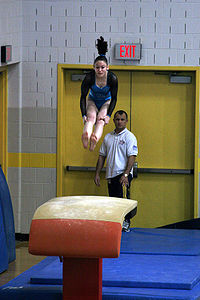
Vault (gymnastics)
The vault is an artistic gymnastics apparatus, as well as the skill performed using that apparatus. Vaulting is also the action of performing a vault. Both male and female gymnasts perform the vault...
: In the vaulting events gymnasts sprint down a 25 metres (82 ft) runway, jump onto a beatboard or springboard (run/ take-off segment), land momentarily, generally inverted on the hands on the vaulting horse or vaulting table (pre flight segment), then spring off of this platform to a two footed landing (post flight segment). Every gymnast starts at a different point on the vault runway depending on their height and strength. The post flight segment may include one or more multiple saltos or somersaults, and/or twisting movements. Round-off entry vaults are the most common vaults. In vaults with roundoff entries, gymnasts "round-off" so hands are on the runway while the feet land on the springboard (beatboard). From the roundoff position the gymnast travels backwards as in a backhandspring so that the hands land on the vaulting platform (horse). She then blocks off the vaulting platform into various twisting and somersaulting combinations. The post flight segment brings the gymnast to her feet.
- In 2001, the traditional vaulting horse was replaced with a new apparatus, sometimes known as a tongue or table. The new apparatus is more stable, wider, and longer than the older vaulting horse—approximately 1m in length and 1m in width—gives gymnasts a larger blocking surface, and is therefore safer than the old vaulting horse. With the addition of this new, safer vaulting table, gymnasts are attempting more difficult and dangerous vaults.
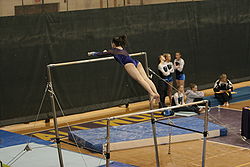
United Kingdom
The United Kingdom of Great Britain and Northern IrelandIn the United Kingdom and Dependencies, other languages have been officially recognised as legitimate autochthonous languages under the European Charter for Regional or Minority Languages...
), the gymnast performs a routine on two horizontal bars set at different heights. These bars are made of fiberglass covered in wood laminate, to prevent them from breaking. In the past, bars were made of wood, but the bars were prone to breaking, providing an incentive to switch to newer technologies. The width of the bars may be adjusted. Gymnasts perform swinging, circling, transitional, and release moves, that may pass over, under, and between the two bars. Movements may pass through the handstand. Gymnasts often mount the Uneven Bars using a springboard.
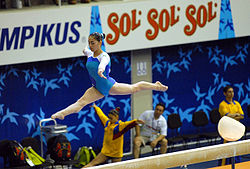
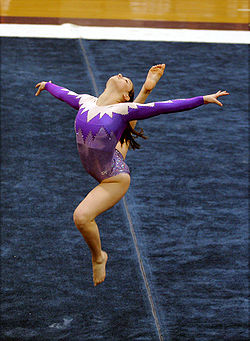
Floor (gymnastics)
In gymnastics, the floor refers to a specially prepared exercise surface, which is considered an apparatus. It is used by both male and female gymnasts. The event in gymnastics performed on floor is called floor exercise. The English abbreviation for the event in gymnastics scoring is FX.A spring...
:In the past, the Floor Exercise event was executed on the bare floor or mats such as wrestling mats. Today, the floor event occurs on a carpeted 12m × 12m square, usually consisting of hard foam over a layer of plywood, which is supported by springs or foam blocks generally called a "spring" floor. This provides a firm surface that provides extra bounce or spring when compressed, allowing gymnasts to achieve extra height and a softer landing than would be possible on a standard floor. Gymnasts perform a choreographed routine up to 90 seconds in the Floor Exercise event. They must choose an accompanying music piece. In some gymnastic associations such as United States Association of Gymnastic Clubs (USAIGC), gymnasts are allowed to have vocals in their music but USA Gymnastics competitions a large deduction is taken from the score for having vocals in the music., The routine should consist of tumbling lines, series of jumps, dance elements, acrobatic skills, and turns, or piviots, on one foot. A gymnast can perform up to four tumbling lines that include at least one flight element without hand support. Each level of gymnastics requires the athlete to perform a different number of tumbling passes, in level 7 you are required to do 2–3 and in levels 8–10 at least 3–4 tumbling passes are required.
Scoring
Code of Points (artistic gymnastics)
A Code of Points is a rulebook that defines the scoring system for each level of competition in gymnastics. There is no unified, international code of points; every oversight organization—such as FIG , NCAA Gymnastics, and most national gymnastics federations—designs and employs its own unique Code...
:
A gymnast's score comes from deductions taken from their start value. The start value of a routine is calculated based on the difficulty of the elements the gymnast attempts and whether or not the gymnast meets composition requirements. The composition requirements are different for each apparatus. This score is called the D score. Deductions in execution and artistry are taken from 10.0. This score is called the E score. The final score is calculated by taking deductions from the E score, and adding the result to the D score.
And since 2007, the scoring system has changed by adding bonus plus the execution and then adding those two together to get the final score.
Events for men
FloorFloor (gymnastics)
In gymnastics, the floor refers to a specially prepared exercise surface, which is considered an apparatus. It is used by both male and female gymnasts. The event in gymnastics performed on floor is called floor exercise. The English abbreviation for the event in gymnastics scoring is FX.A spring...
: Male gymnasts also perform on a 12m. by 12m. spring floor. A series of tumbling passes are performed to demonstrate flexibility, strength, and balance. The gymnast must also show strength skills, including circles, scales, and press handstands. Men's floor routines usually have four passes that will total between 60–70 seconds and are performed without music, unlike the women's event. Rules require that male gymnasts touch each corner of the floor at least once during their routine.
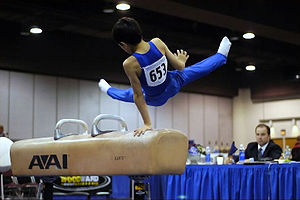
Pommel horse
The pommel horse is an artistic gymnastics apparatus. Traditionally, it is used by only male gymnasts. Originally made of a metal frame with a wooden body and a leather cover, modern pommel horses have a metal body covered with foam rubber and leather, with plastic handles .- History :The pommel...
: A typical pommel horse exercise involves both single leg and double leg work. Single leg skills are generally found in the form of scissors, an element often done on the pommels. Double leg work however, is the main staple of this event. The gymnast swings both legs in a circular motion (clockwise or counterclockwise depending on preference) and performs such skills on all parts of the apparatus. To make the exercise more challenging, gymnasts will often include variations on a typical circling skill by turning (moores and spindles) or by straddling their legs (Flares). Routines end when the gymnast performs a dismount, either by swinging his body over the horse, or landing after a handstand.
Still Rings
Rings (gymnastics)
The rings, also known as still rings , is an artistic gymnastics apparatus and the event that uses it. It is traditionally used only by male gymnasts, due to its extreme upper-body strength requirements...
: The rings are suspended on wire cable from a point 5.75 metres from the floor, and adjusted in height so the gymnast has room to hang freely and swing. He must perform a routine demonstrating balance, strength, power, and dynamic motion while preventing the rings themselves from swinging. At least one static strength move is required, but some gymnasts may include two or three. A routine should have a dismount equal in difficulty to the difficulty of the routine as a whole.
Vault
Vault (gymnastics)
The vault is an artistic gymnastics apparatus, as well as the skill performed using that apparatus. Vaulting is also the action of performing a vault. Both male and female gymnasts perform the vault...
: Gymnasts sprint down a runway, which is a maximum of 25 metres in length, before hurdling onto a spring board. The body position is maintained while "punching" (blocking using only a shoulder movement) the vaulting platform. The gymnast then rotates to a standing position. In advanced gymnastics, multiple twists and somersaults may be added before landing. Successful vaults depend on the speed of the run, the length of the hurdle, the power the gymnast generates from the legs and shoulder girdle, the kinesthetic awareness in the air, and the speed of rotation in the case of more difficult and complex vaults.
Parallel Bars: Men perform on two bars slightly further than a shoulder's width apart and usually 1.75m high while executing a series of swings, balances, and releases that require great strength and coordination.
High Bar
Horizontal bar
The high bar, also known as the horizontal bar, is an apparatus used by male gymnasts in Artistic Gymnastics. It traditionally consists of a cylindrical metal bar that is rigidly held above and parallel to the floor by a system of cables and stiff vertical supports. Gymnasts typically wear leather...
: A 2.8 cm thick steel or fiberglass bar raised 2.5m above the landing area is all the gymnast has to hold onto as he performs giants (revolutions around the bar), release skills, twists, and changes of direction. By using all of the momentum from giants and then releasing at the proper point, enough height can be achieved for spectacular dismounts, such as a triple-back salto. Leather grips
Grip (gymnastics)
Grips are devices that are worn on the hands of artistic gymnasts when performing on various gymnastics apparatus. They are worn by female gymnasts on the uneven bars, and by male gymnasts on the high bar, still rings and parallel bars...
are usually used to help maintain a grip on the bar.
As with the women, male gymnasts are also judged on all of their events, for their execution, degree of difficulty, and overall presentation skills.
Rhythmic gymnastics
Only women compete in rhythmic gymnastics although there is a new version of this discipline for men being pioneered in JapanJapan
Japan is an island nation in East Asia. Located in the Pacific Ocean, it lies to the east of the Sea of Japan, China, North Korea, South Korea and Russia, stretching from the Sea of Okhotsk in the north to the East China Sea and Taiwan in the south...
, see Men's rhythmic gymnastics. This is a sport that combines elements of ballet
Ballet
Ballet is a type of performance dance, that originated in the Italian Renaissance courts of the 15th century, and which was further developed in France and Russia as a concert dance form. The early portions preceded the invention of the proscenium stage and were presented in large chambers with...
, gymnastics, dance
Dance
Dance is an art form that generally refers to movement of the body, usually rhythmic and to music, used as a form of expression, social interaction or presented in a spiritual or performance setting....
, and apparatus manipulation. The sport involves the performance of five separate routines with the use of five apparatus—ball, ribbon, hoop, clubs, rope—on a floor area, with a much greater emphasis on the aesthetic rather than the acrobatic. There are also group routines consisting of 5 gymnasts and 5 apparatuses of their choice. Rhythmic routines are scored out of a possible 30 points; the score for artistry (choreography and music) is averaged with the score for difficulty of the moves and then added to the score for execution.
International competitions are split between Juniors, under sixteen by their year of birth; and Seniors, for women sixteen and over again by their year of birth. Gymnasts in Russia and Europe typically start training at a very young age and those at their peak are typically in their late teens (15–19) or early twenties. The largest events in the sport are the Olympic Games
Olympic Games
The Olympic Games is a major international event featuring summer and winter sports, in which thousands of athletes participate in a variety of competitions. The Olympic Games have come to be regarded as the world’s foremost sports competition where more than 200 nations participate...
, World Championships
World Rhythmic Gymnastics Championships
The World Rhythmic Gymnastics Championships are the World Championships for the sport of rhythmic gymnastics. They were first held in 1963.-Championships:-Individual All-Around:-Group All-Around:-Total All-Around medals by country:...
, and Grand-Prix Tournaments.
Trampolining and tumbling
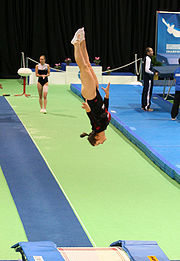
Trampolining and tumbling consists of four events, individual, synchronized, double mini and tumbling (also known as power tumbling). Since 2000, individual trampoline has been included in the Olympic Games. Individual routines in trampolining involve a build-up phase during which the gymnast jumps repeatedly to achieve height, followed by a sequence of ten leaps without pauses during which the gymnast performs a sequence of aerial skills. Routines are marked out of a maximum score of 10 points. Additional points (with no maximum at the highest levels of competition) can be earned depending on the difficulty of the moves and the length of time taken to complete the ten skills which is an indication of the average height of the jumps. In high level competitions, there are two preliminary routines, one which has only two moves scored for difficulty and one where the athlete is free to perform any routine. This is followed by a final routine which is optional. Some competitions restart the score from zero for the finals, other add the final score to the preliminary results.
Synchronized trampoline is similar except that both competitors must perform the routine together and marks are awarded for synchronicity as well as the form and difficulty of the moves.
Double mini trampoline involves a smaller trampoline with a run-up, two moves are performed for preliminaries and two more for finals. Moves cannot be repeated and the scores are marked in a similar manner to individual trampoline. In tumbling, athletes perform an explosive series of flips and twists down a sprung tumbling track. Scoring is similar to trampolining.
Acrobatic gymnastics
Acrobatic gymnastics (formerly Sports Acrobatics), often referred to as acro if involved with the sport, acrobatic sports or simply sports acro, is a group gymnastic discipline for both men and women. Acrobats in groups of two, three and four perform routines with the heads, hands and feet of their partners. They may, subject to regulations (e.g. no lyrics), pick their own music.Throughout the world, there at three FIG levels: Age group (Age 11-16), Junior(12-19) and Senior (15+), which are used in the World Championships and many other events around the world, including European Championships and World Games. All levels require a balance and dynamic routine, Junior and Seniors are also required to perform a final (combined) routine.
Currently acrobatic gymnastics is marked out of 30.00 (can be higher at Senior FIG level based on difficulty):
10.00 for routine difficulty, (valued from the tables of difficulties)
10.00 For technical performance, (how well the skills are executed)
10.00 For Artistry, (the overall performance of the routine, namely choreography)
TeamGym
Team Gym or Gymnastics for All has it origins in earliest times.These days, although teams can compete the sport itself was developed to enhance fitness and health in the participants and is accessible to anyone of any age. In 1984 Gymnastics for All was officially recognized first as a Sport Program by the FIG (International Gymnastic Federation), and subsequently by national gymnastic federations world wide with participants that now number 30 million.Floor Programme: All members of the Team take part in the floor program, composed of a mixture of dance, flexibility and skill. The routine has to be skillfully choreographed and the judges look out for changes in shape. There needs to be at least two spins, two balances and two section elements. These section elememts are bodywaves for women's teams, power elements for men's teams and lifts for mixed teams. Floor routines are performed to music.
Trampette
Trampette
A trampette is a small square trampoline used in gymnastics. Trampette is one of three disciplines in the sport TeamGym.-TeamGym Discipline:...
: Here a trampette is used. There are two components of this; Vault and the Trampette on its own. There has to be three runs in total. At least one of these runs has to be a vault run. Another run has to include all the gymnasts doing the same move. This is generally the first run. This is also performed to music.
Tumbling: Again, here there are three runs (rounds) involved. One of which has to include all six gymnasts doing a forwards series. Another run also has to include the gymnasts completing the same move. Each series must have at least three different acrobatic elements.
Display gymnastics
General gymnastics enables people of all ages and abilities to participate in performance groups of 6 to more than 150 athletes. They perform synchronized, choreographed routines. Troupes may be all one gender or mixed. There are no age divisions in general gymnastics. The largest general gymnastics exhibition is the quadrennial World GymnaestradaWorld Gymnaestrada
The World Gymnaestrada is the largest general gymnastics exhibition. It is held every four years much like the Olympics. But the focus of this event is not on winning medals. The Gymnaestrada is about Group Performances – some with hundreds or even thousands of participants. Adults and children of...
which was first held in 1939.
Aerobic gymnastics
Aerobic gymnastics (formally Sport Aerobics) involves the performance of routines by individuals, pairs, trios or groups up to 6 people, emphasizing strength, flexibility, and aerobic fitness rather than acrobatic or balance skills. Routines are performed for all individuals on a 7x7m floor and also for 12–14 and 15–17 trios and mixed pairs. From 2009, all senior trios and mixed pairs were required to be on the larger floor (10x10m), all groups also perform on this floor. Routines generally last 60–90 seconds depending on age of participant and routine category.Rope (rhythmic gymnastics)
Starting in 2011, the rhythmic apparatus rope will be removed from all FIG events and clubs will be returned to the competition. FIG has a policy of only using four of the five pieces of apparatus and changes them for different Olympic cycles. This will affect World Cups, World Championships, and Olympics.Rope climb
Generally, competitors climbed either a 6m (6.1m = 20 ft in USA) or an 8m (7.6m = 25 ft in USA), 38mm (1.5") diameter natural fiber rope for speed, starting from a seated position on the floor and using only the hands and arms. Kicking the legs in a kind of "stride" was normally permitted. Many gymnasts can do this in the straddle or pike position, which eliminates the help generated from the legs.Flying rings
Flying rings was an event similar to still rings, but with the performer executing a series of stunts while swinging. It was a gymnastic event sanctioned by both the NCAA and the AAUAmateur Athletic Union
The Amateur Athletic Union is one of the largest non-profit volunteer sports organizations in the United States. A multi-sport organization, the AAU is dedicated exclusively to the promotion and development of amateur sports and physical fitness programs.-History:The AAU was founded in 1888 to...
until the early 1960s.
Film
- American AnthemAmerican AnthemAmerican Anthem is a 1986 American film produced by Lorimar Motion Pictures and released in North America by Columbia Pictures. It was directed by Albert Magnoli, and starred Mitch Gaylord and Janet Jones. The subject of the film was a football player turned gymnast that was seeking to join the...
- FlyingFlying (1986 film)Flying is 1986 drama film directed by Paul Lynch and starring Olivia d'Abo, Rita Tushingham and Keanu Reeves.-Cast:...
- GymkataGymkataGymkata is a 1985 martial arts film starring Olympic gymnast Kurt Thomas as Jonathan Cabot, an Olympic gymnast who combines his gymnastic ability with ninjutsu to enter a deadly competition in a fictional country, Parmistan...
- Little Girls in Pretty BoxesLittle Girls in Pretty BoxesLittle Girls in Pretty Boxes: The Making and Breaking of Elite Gymnasts and Figure Skaters is a 1995 nonfiction book by San Francisco Chronicle sports writer Joan Ryan detailing the difficult training regimens endured by young women in competitive sports such as gymnastics and ice skating,...
- Make It or Break It
- Nadia
- Peaceful WarriorPeaceful WarriorPeaceful Warrior is a 2006 drama film starring Scott Mechlowicz, Nick Nolte, and Amy Smart. Released on June 2, 2006, it is based on the novel Way of the Peaceful Warrior by Dan Millman.The film is set in U.C. Berkeley but is shot elsewhere...
- Perfect BodyPerfect BodyPerfect Body is a 1997 American drama film about a young gymnast who develops an eating disorder. It originally aired on NBC on September 8, 1997. It has since aired on Lifetime and ABC Family and been released on DVD. The film stars former Power Rangers and Felicity actress Amy Jo...
- A State of MindA State of MindA State of Mind is a 2004 documentary film directed by Daniel Gordon and produced by Nicholas Bonner. The film follows two North Korean child gymnasts and their families for over eight months during training for the 2003 Pyongyang mass games...
- Stick ItStick ItStick It is an American teen comedy-drama film starring Jeff Bridges, Missy Peregrym, and Vanessa Lengies. It was written and directed by Jessica Bendinger, writer of Bring It On; the film marks her directorial debut...
- The GymnastThe Gymnast"The Gymnast" is the 92nd episode of Seinfeld. This was the 6th episode for the 6th season. It aired on November 3, 1994, during a special "Blackout Thursday" night on NBC, in which all shows in the Must See TV line-up, except this one, featured a fictional New York City blackout .- Plot :Jerry...
See also
- AcrobaticsAcrobaticsAcrobatics is the performance of extraordinary feats of balance, agility and motor coordination. It can be found in many of the performing arts, as well as many sports...
- Acro danceAcro danceAcro dance is a style of dance that combines classical dance technique with precision acrobatic elements. It is defined by its athletic character, its unique choreography, which seamlessly blends dance and acrobatics, and its use of acrobatics in a dance context...
- Gymnasium (ancient Greece)Gymnasium (ancient Greece)The gymnasium in ancient Greece functioned as a training facility for competitors in public games. It was also a place for socializing and engaging in intellectual pursuits. The name comes from the Ancient Greek term gymnós meaning "naked". Athletes competed in the nude, a practice said to...
- List of gymnasts
- List of gymnastics terms
- International Gymnastics Hall of FameInternational Gymnastics Hall of FameThe International Gymnastics Hall of Fame, located in Oklahoma City, USA, is a hall of fame dedicated to honoring the achievements and contributions of the world's greatest competitors, coaches and authorities in artistic gymnastics....
- World Gymnastics ChampionshipsWorld Gymnastics ChampionshipsThe Fédération Internationale de Gymnastique organises World Gymnastics Championships for each of the gymnastic disciplines:...
- NCAA Men's Gymnastics championshipNCAA Men's Gymnastics championshipThis is a list of National Collegiate Athletic Association Men's Gymnastics champions, by division and year. All schools currently compete in one division, because only 17 schools sponsor men's gymnastics teams...
(US) - NCAA Women's Gymnastics championshipNCAA Women's Gymnastics championshipThe NCAA introduced Women's Gymnastics as a championship sport in 1982. Since then, only four universities have claimed the overall Division I championship; Division II competition was discontinued in 1987. During the early years of competition, the University of Utah under the leadership of head...
(US) - TurnersTurnersTurners are members of German-American gymnastic clubs. A German gymnastic movement was started by Turnvater Friedrich Ludwig Jahn in the early 19th century when Germany was occupied by Napoleon...
- MajorettesMajorettesBaton twirling is an activity involving the manipulation of a metal rod and the human body to a coordinated routine and is similar to rhythmic gymnastics or color guard . Twirling combines dance and gymnastics while manipulating a single baton or multiple batons. It is primarily performed with the...
- CheerleadingCheerleadingCheerleading is a physical activity, sometimes a competitive sport, based on organized routines, usually ranging from one to three minutes, which contain the components of tumbling, dance, jumps, cheers, and stunting to direct spectators of events to cheer on sports teams at games or to participate...
External links
}
}
}}

